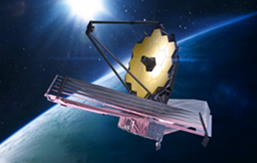

Context
Recently, the National Aeronautics and Space Administration (NASA) announced that the James Webb Space Telescope has discovered its first new exoplanet named LHS 475 b, of the same size as Earth.
The James Webb Telescope:
- NASA's James Webb Space Telescope, the agency's successor to the famous Hubble telescope, launched on Dec. 25, 2021, on a mission to study the earliest stars and peer back farther into the universe's past than ever before.
- The James Webb Space Telescope is the largest, most powerful space telescope ever built.
- It is able to observe objects in our solar system from Mars outward, look inside dust clouds to see where new stars and planets are forming and examine the atmospheres of planets orbiting other stars.
- The James Webb Space Telescope will use its infrared cameras to see through dust in our universe.
- Stars and planets form inside those dust clouds, so peeking inside could lead to exciting new discoveries.
- It will also be able to see objects (like the first galaxies) that are so far away that the expansion of the universe has made their light shift from visible to infrared Webb has a sun shield to protect its instruments and mirrors as the Webb telescope’s cameras are sensitive to heat from the Sun.

What are exoplanets?
- Exoplanets are planets that orbit other stars and are beyond our solar system.
|
According to NASA, more than 5,000 exoplanets have been discovered. Scientists believe that there are more planets than stars as each star has at least one planet orbiting it. |
Characteristics:
- They can be gas giants bigger than Jupiter or as small and rocky as Earth.
- They are also known to have different kinds of temperatures, from boiling hot to freezing cold.
The LHS 475 b exoplanet:
- It is located just 41 light-years away and the planet orbits very close to a red dwarf star and completes a full orbit in just two days.
- LHS 475 b is relatively close, 41 light-years away, and belongs to the constellation Octans.
Why they are studied?
- Studying exoplanets broadens our understanding of other solar systems and also helps us piece together information about our own planetary system and origin.
- However, the most compelling reason to learn about them is to find the answer to one of the most profound and thought-provoking questions of humankind.
- Finding out the distance between an exoplanet and its host star helps scientists determine if a discovered world is habitable or not.
- If an exoplanet is too close to the star, it might be too hot to sustain liquid water. If it’s too far, it might only have frozen water.
- When a planet is at a distance that enables it to have liquid water, it is said to be in the “Goldilocks zone”.
How they are discovered?
- Discovering exoplanets is quite tough as they are small and hard to spot around their bright host stars.
- Scientists rely on indirect methods, such as the transit method, which is measuring the dimming of a star that happens to have a planet pass in front of it.

